|
July 21
It felt quite cold this morning,
and we huddled under our blankets in the back of the
Landcruiser. It was a significant temperature swing from the
low forties in the early morning hours to the eighties in the
afternoon, so we knew we would soon be shedding layers.
We
stopped briefly for ‘Sun-uppers,’ watching as the pastel
shades of pre-dawn gave way to the fiery sky of sunrise. The
landscape was serene and beautiful. We could hear the low whoo-whoo
call of a giant eagle owl somewhere in the trees.
A small herd of impala crossed the
road in front of us, their chestnut coats gleaming in the early
morning sunlight. A tawny eagle surveyed the area from a lofty
perch; these regal birds are among my favorite African raptors.
We
followed Leopard Drive to the den, but the mother leopard was not
home - Gee said she must be out hunting. We went looking for her;
we found her tracks in the sand and followed her spoor until she
turned off the road and into the bush. We stopped often to listen
for alarm calls from impala or birds that might give away her
location, but all was quiet. The elusive leopardess did not want
to be found.
We went back to the area where we
had seen the honeymooning lions the previous day, but there was no
sign of them. We heard via the two-way radio that two wild dogs
had just run through our camp.
Gee
stopped to check the tires, and then we headed out toward Marabou
Pan. We passed a couple of kudus and a lone elephant eating a
bush. We picked up some lion tracks in the road and followed them.
Eventually we saw a lone lioness, walking purposefully across the
plain to our left. We turned off on a tiny track hoping to
shortcut and get ahead of her, but when we got to the other side
she was already past us.
We left off following the lioness
and went to look for the rest of the Marsh
Pride. We passed a
herd of impala with a single wildebeest; it was the same group we
had watched the lions stalking the day before - we wondered if
their numbers were one fewer.
|
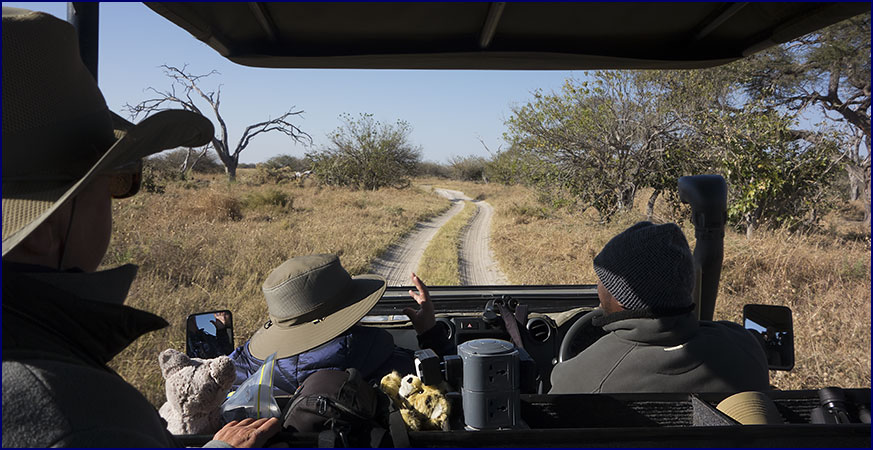
Following lion prints
on the road
|
There
were many lion tracks in the roadway; the pride had been walking
here. We followed the prints in the dusty road for a long way. We
stopped to watch a few things along the way; a secretary bird
hunched in the cold, a pair of jackals hunting, a family of
warthogs snuffling around for food. Then we got a radio call that
the lions had killed.
As we hurried toward the
lion kill, we paused to watch a jackal trying to catch a
Guineafowl. He dashed into the flock, leaping in the air in an
effort to snag one, making them fly up squawking and scatter like
chickens. The jackal seemed to take delight in the racket; we
weren't sure if he really expected to catch one or was just having
fun.
|
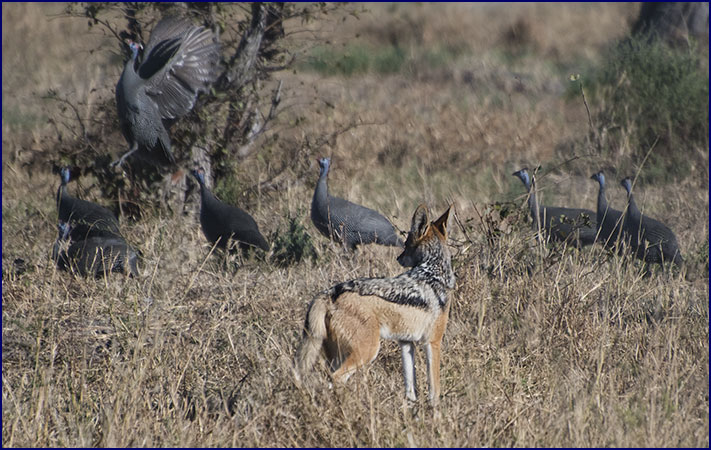
Hunting for
Guineafowl
|
We
found the Marsh Pride, or at least part of it. There was a mother lioness with
three youngsters - a son and two daughters around a year old - and
an old female who was probably the grandmother. They were eating
what looked like the remains of a tsessebe.
Before long the lioness and the
three youngsters stood up and walked past the vehicles, their full
bellies bulging, heading for a nearby water hole. The grandma
stayed behind and continued eating; we realized that she was the
same old thin lioness we had seen the day before sleeping in the
sun. We were glad that she was getting a good meal – she looked
like she needed it.
Gee
drove us to the water hole to wait for the lions. The mother and
the three young ones strode toward us across the plain, pausing
often to look around warily. They stopped about a hundred meters
from us and stood very still, all of them looking intently out
across the plain in the same direction. Gee said maybe a new male
had come into the area and the lioness was worried that he may try
to kill her cubs; he wasn’t sure what else would make them so
nervous.
Presently
the lions came down to the waterhole. First the mother crouched by
the water, and one by one the cubs joined her. They were reflected
in the pool like a mirror as they put their heads down to drink.
They stayed there for a long time, occasionally shifting positions
along the edge of the waterhole. They seemed to like to drink from
the same spot, shoulders touching and heads pressed together. It
was spectacular. We felt privileged to get the chance to see it.
After a while the lions finished drinking, and then slowly walked
off across the plain.
We
went back to the kill where the old grandmother was still dining.
She seemed very content to be able to eat her fill. A jackal,
emboldened by her passive demeanor, snuck up to steal scraps.
After grabbing a few tidbits he became bolder, stepping up and
seizing a bloody chunk of flesh almost as big as he was. Rob, the
doctor, said in his medical opinion it looked like a lung. The
jackal trotted off triumphantly, his prize held high. He must have
hidden it, because soon he was back looking for more.
|
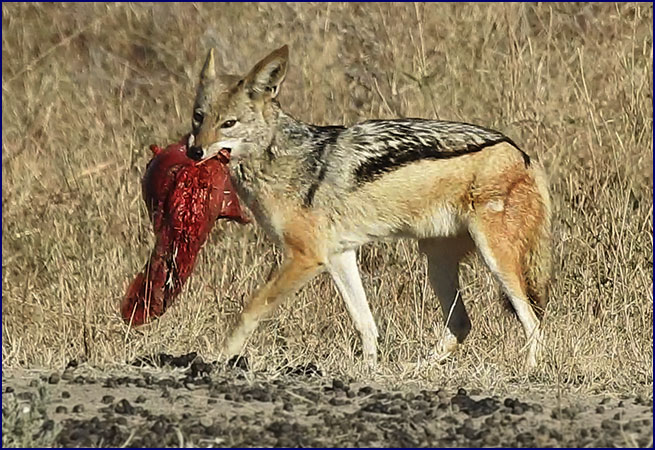
A prize!
|
Gee
told us about the lifestyle of lions. It is better to be a female,
he explained, as they stay with the pride. Males are pushed out at
2 ˝ to 3 years of age, and then they usually form coalitions with
other male lions and hunt together. If he grows strong enough a
male lion can eventually take over a pride, but he has to fight to
win it, and then fight to keep it. In the pride the lionesses do
most or the hunting while the male defends the territory from
other lions. Eventually when he gets older a younger male will
push him out and take over the pride; then he must scavenge for
food alone. Sometimes an old lion will make an uneasy alliance
with the hyenas and they will hunt and scavenge together, but the
hyenas will eventually turn on the lion and kill him. This all
reminded me of the character Scar
in The Lion King; I hadn't realized it was so realistic.
|
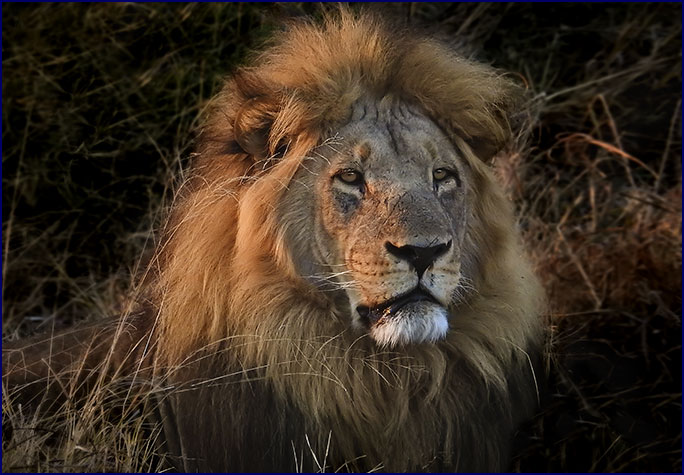
The Marsh Pride leader
|
This
started us on a new conversation: if you were going to be an
animal in Africa, which one would you want to be? Definitely
something the lions don’t hunt! And not an elephant, because of
poachers. I was thinking maybe a leopard, but they live a very
lonely solitary lifestyle. Paula said she would be a hornbill. She
changed her mind later when she saw one feeding; she said she
didn't want to have to eat maggots. We asked Gee which animal he
would most like to be; he answered, “An Angel.” Hard to argue
with that.
We
stopped for our tea break at a particularly lovely water hole in
the woods, with tall trees around it. We got out of the
Landcruiser and stretched our legs. A fork-tailed drongo looked
down at us from a tree, an attractive little black bird with a
forked tail. Gee checked out a bush for us; he always went first
to be sure there were no predators lurking before giving us the
go-ahead.
Gee cautioned us not to walk close
to the water; he said the hippo can be particularly aggressive,
pointing to a flat rock in the water that did look a little like a
hippo’s back. Good joke, except that I knew there were not any
hippos in Savuti, plus we could see a sharp edge along the top of
the rock. Even so, several people in our group sort of half
believed him.
Suddenly
Gee instructed us to Be one
with the vehicle, and we all climbed back in. Four large
elephants came walking silently through the trees and strolled
right past the Landcruiser. They went to the edge of the water and
stood quietly for a few minutes, and then went around to the far
side of the waterhole and lined up facing us, spaced evenly apart.
All four were bulls, and they were huge.
The
elephants seemed very relaxed, and took their time drinking. They
would suck up large amounts of water in their trunks and squirt it
into their mouths. One of them stood with his legs casually
crossed, and several of them rested their trunk over a tusk
nonchalantly. When the ‘hippo rock’ never moved even when the
ellies stood almost on top of it, then we knew for sure that it
was a joke.
|
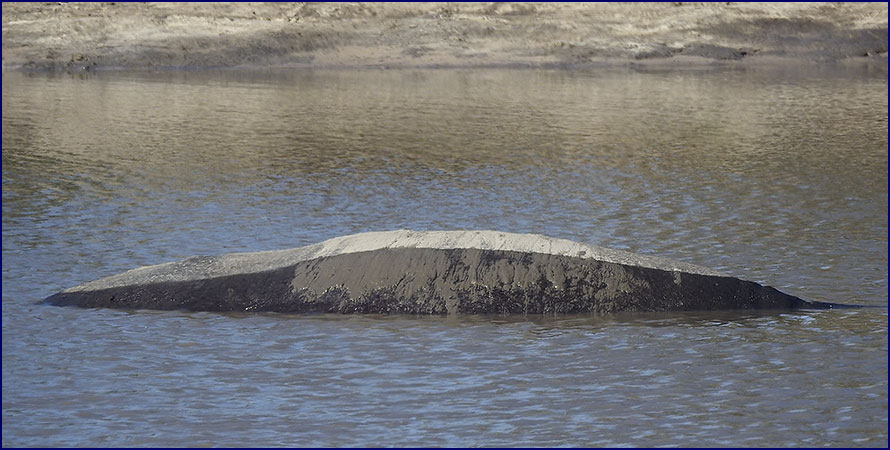
Rock or Hippo? |
The
four elephants stood there, legs motionless but heads and trunks
moving slowly back and forth. They looked like a scene at
Disneyland, with animatronic elephants standing beside an
artificial rock hippo. In fact, I was thinking, even at Disney you
would say that this scene was a little too perfect to be
believable. And that was the moment the hippo rock raised its nose
up out of the water. Holy crap! It really is
a hippo!
Even
then I wasn’t totally convinced; Gee had played tricks on me
before. When we left I got him to show me the hippo/rock from a
different angle; then I could see that what had looked like a
sharp edge of rock was actually the water line on the hippo’s
back. Gee never did explain what one lone hippo was doing in a
waterhole in Savuti, miles from the river.
|
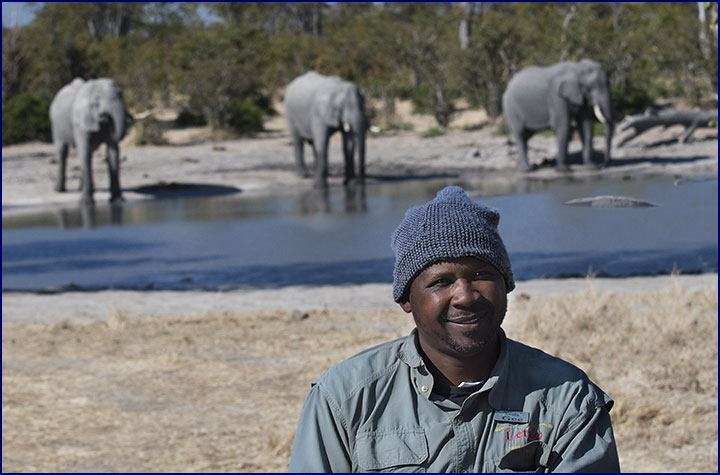
Gee at the waterhole
|
We
went back to the lion kill. We could get closer now that the pride
was gone, and we saw that the carcass was actually a wildebeest,
not a tsessebe. We thought of those poor wildebeest calves bawling
for their mothers a few days earlier; there must be one more
orphan now. Gee told us that in most places lions will stick to
smaller game like wildebeest, tsessebe and impala, but some prides
in Chobe will kill buffalo and even elephants. The jackal was
still there, picking at the carcass, now with a very fat stomach.
The old grandmother lioness was lying contentedly in the shade not
far away.
A
tawny eagle soared high above us, riding the air currents with
ease. A yellow-billed hornbill sat in a dead tree by the road and
peered at us with interest; these charismatic birds have a
clown-like quality to them that makes me want to laugh.
Over
at the lions’ waterhole a large warthog was taking a mud bath.
He groveled in the wet muck, getting himself well coated, and then
sat there on his haunches, glistening wet, with four or five
oxpeckers clinging to his back. Patty suggested that the
collective noun should be a wallow
of warthogs, but Gee said they are called a drift.
|
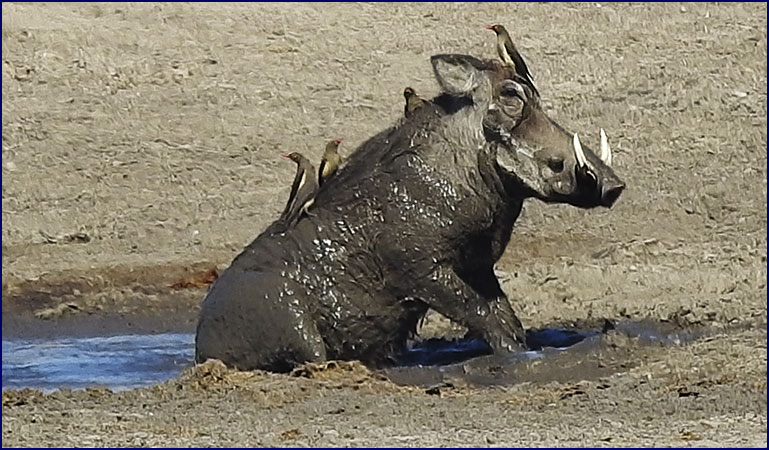
The
Warthog Spa |
Gee
heard a radio report about a possible leopard sighting, so we
drove slowly along the dry riverbed searching for it. Before long
we found the leopard lying by the base of a large tree. There was
one other vehicle there, but it soon left and Gee was able to park
in a good viewing position.
The
leopard was resting; he had his head up but his eyelids were
drooping sleepily. Every so often he would wake up a bit and look
around, then glance up in the tree. Following his gaze upward, we
could see a bloody ribcage with some cloven-hooved legs dangling
down; our leopard had killed an impala and stashed the remains
high in the tree, out of reach or hyenas and lions. Presently he
sat up and yawned expansively, showing off some impressive
incisors and looking very fierce. Then he flopped over on his
side, closed his eyes and went back to sleep.
After
a while the leopard stood up, stretched and yawned, and then
gracefully leaped up into the tree. He was beauty and elegance in
action. He paused half way up the trunk and looked back over his
shoulder, as if posing for a photo op. Then he walked further up
the tree as easily as if it was a staircase, and then turned and
nimbly leapt up to the high branch where his dinner was waiting.
We watched as he leisurely ate some of the impala, confident that
it was secure from predators. Imagine the strength it took to
carry that impala high up in the tree.
After
a while we left the leopard to finish his meal in private.
We passed a buffalo skull in the road, complete with
curving horns, and we noted that we had not seen any actual
buffalo yet - they must all be hiding.
We headed back to camp for lunch. What a marvelous morning
it had been! Since Jineen and I had been on safari with Gee
before, he knew us and what we liked to see (everything!). He had
taken up right where he left off at the end of the last trip with
knowing how to show us a good time.
We
made use of the bucket showers after lunch, and had a little while
to relax, sitting in the camp chairs in front of our tents. A
brilliant blue Burchell’s starling lit in a tree by our tent,
its indigo feathers gleaming in the dappled sunlight; starlings in
Africa are very different from the ones at home, and far more
beautiful.
|

Burchell’s starling |
We
went back out for the afternoon game drive just after 2:30. A
lappet-faced vulture was sitting in the top of a dead tree, and it
took off flying when we drew near. It was huge; Gee said these are
the largest of the vultures, and quite rare. A kori bustard walked
along near the roadway; this was the closest look we had gotten to
one of these large handsome birds. We drove past a dense thicket
of mopane trees, and we could see two giraffe heads sticking up
out of them. They rubbed up against each other, their graceful
necks crossing to form a giant X.
We
drove back to the elephant spa, the series of waterholes near
camp. Half a dozen giraffes were there eating the treetops. A
group of two adults and one youngster stood close together, their
elegant necks intertwining. Several
of them rubbed their heads and necks together to scratch their
itches. The giraffes’ reflections shimmered in the water, but
they showed no interest in drinking. One of them was pregnant; Gee
said they have a gestation period of 14 months.
|
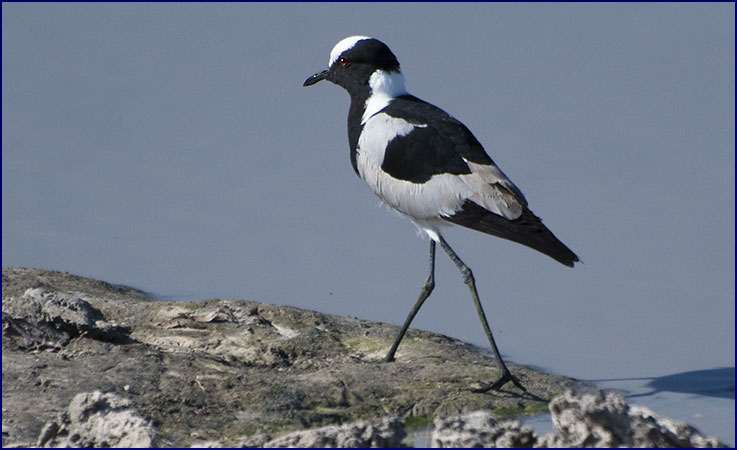
Blacksmith plover
|
A
flock of Guineafowl came to drink at the edge of the water, and a
handsome blacksmith plover waded in the shallows. A
Crimson-breasted shrike perched on a stump; he had a brilliant red
breast, a black back and a white stripe on his wings. A Burchell's
starling took a very splashy bath in the pan.
Moving
on toward the next waterhole, we passed a herd of zebras. They
stood facing us, letting us get much closer than usual before
turning their rumps toward us in typical zebra fashion. One
youngster one still sported a shaggy baby coat. Gee said that the
zebra is the national animal of Botswana.
There
was a large herd of giraffes nearby – there must have been two
dozen. Gee explained about coalitions between different animals;
giraffes can see far and high up, and zebra can see under the
bushes, so they hang out together to their mutual benefit.
A
lone bull elephant stood by the next pan, admiring his reflection
in the water. His trunk was so long that when he relaxed it and
let it hang down, a foot and a half of it lay flat on the ground.
He began curling and uncurling his trunk and snaking it around his
tusks; he seemed to be showing off for us a little. I
wondered if it was the same elephant who danced for us two
evenings earlier.
Then a bachelor herd of elephants arrived, thirteen of
them, all boys. They came in one after another and lined up along
the far shore. They stood quietly at the edge of the water, some
drinking and some just standing contentedly. A blacksmith plover
was going crazy; one of the elephants was standing too close to
her nest. She kept flying at him trying to drive him away, but he
just ignored her. I was impressed though; 20 ounces of bird going
against 12,000 pounds of muscle, tusk and hide in order to protect
her eggs! Nature is incredible.
Two
of the younger ellies went down to the lower end of the pan and
took a mud bath in the elephant spa. One of them casually swatted
an Egyptian goose out of the way with his trunk. One of the
elephants lay down in the oozy mud and wallowed around, coating
himself thoroughly; then the other one came and leaned over him,
pushing and shoving playfully until he too ended up submerged.
They played and splashed, spraying water and mud all over each
other. One of them put his head down and rooted in the mud like a
warthog, with his whole head under the muddy water and his tail in
the air. After a while one of the big adult bulls waded in to join
the youngsters in the mudhole. They were very affectionate with
each other, rubbing their heads together and intertwining trunks.
The poor Egyptian goose was totally coated with mud by the end.
A couple of the older adolescents were mock fighting under
the trees, face to face with tusks interlocked. Several big bulls
stood serenely by the water, presenting a lovely picture with
their reflections mirrored in the surface. We contentedly watched
the elephants for over an hour, glad that we could spend as much
time as we wanted with them – that is one of the best things
about having our own private safari group.
Finally
leaving the ellies, we continued on across the veld. We paused to
look at a lilac-breasted roller perched on a twig by the road. We
waited for him to fly, cameras poised; these birds display
brilliant colors when they fly, but it is extremely difficult to
catch them in flight. When you see them sitting on a twig you
focus and wait – and wait – and of course as soon as you look
away for an instant they take off. But just before the trip I had
bought a new camera with a tracking mode that made it easier to
focus on moving targets, so I got a few good shots.
|
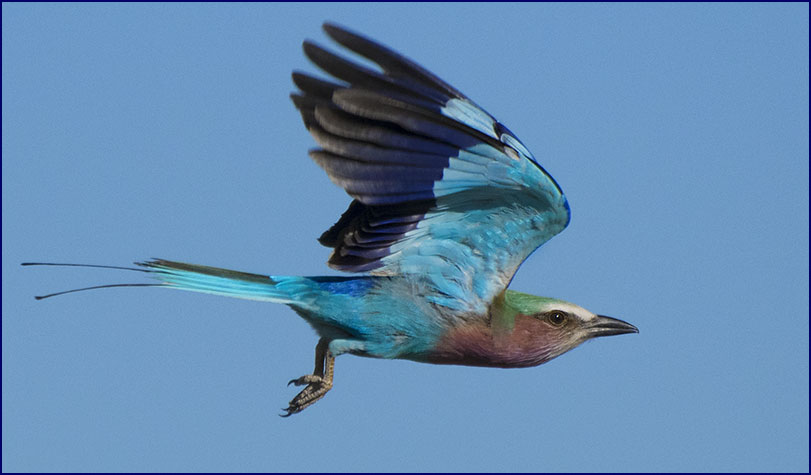
Lilac-breasted
roller in flight |
Near a small waterhole, we passed another group of zebras
with several youngsters, including one of the smallest babies we
had seen yet. Generally zebra foals are all born around the same
time for safety in numbers, but there were definitely a few that
must have been born a little later. The zebras were quite social,
rubbing their heads on one another, and scratching each other’s
necks and withers with their teeth like horses do. One big zebra
had unusually pronounced shadow stripes (the faint brownish
markings amid the white stripes).
The
zebras had plenty of company at the little pan; there was a herd
of impala, one wildebeest and a giraffe. The giraffe crouched down
low by the water to drink. He was leaning back over his hind legs
in a defensive position, ready to spring up and flee at the first
sign of danger
A
very striking Bradfield hornbill perched in a tree, and we stopped
to admire him. Rob,
remembering Paula’s discussion of what animal she would choose
to be, told her, “This is the kind of hornbill you should be - I
bet he doesn’t eat maggots.”
|
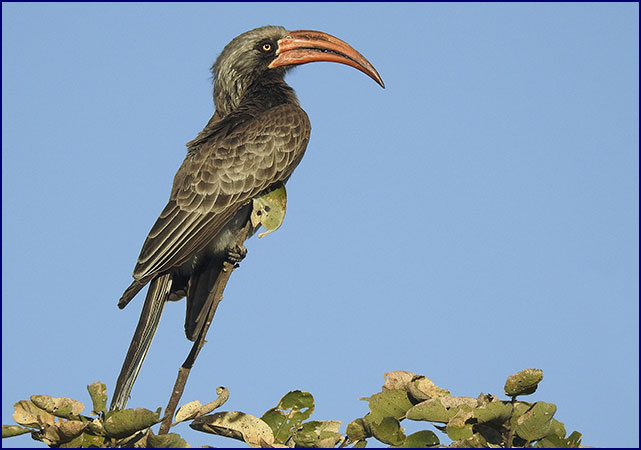
Bradfield
hornbill |
We
passed through a lovely wooded area. The trees were bigger here,
not eaten down by elephants, and the terrain had some gentle
hills. It was definitely a road less travelled; the sand was deep
and we almost got stuck a couple of times. I was sure we had never
come this way on our previous trip; in fact I had only recognized
a few places, such as Leopard Rock and the waterhole pans – on
the whole we were covering a lot of new territory. Gee told us we
were heading for a hyena den.
We passed some skeletal remains of
a buffalo and saw quite a bit of fresh buffalo dung, but we still
had not seen an actual buffalo. We told Gee that we reckoned there
were not actually any live buffalo in Botswana.
We
came around a blind turn and a female kudu was standing right in
the road. “Kudu!” I exclaimed, pointing at her, as Gee slammed
on the brakes to avoid hitting her. “Good spot,” he said drily.
Remarkably she was not scared, but stood looking at us curiously.
Kudus are my favorite antelope, and she was exquisite. From close
quarters, I admired her two-toned brown head, delicate white face
markings and huge velvety ears.
|
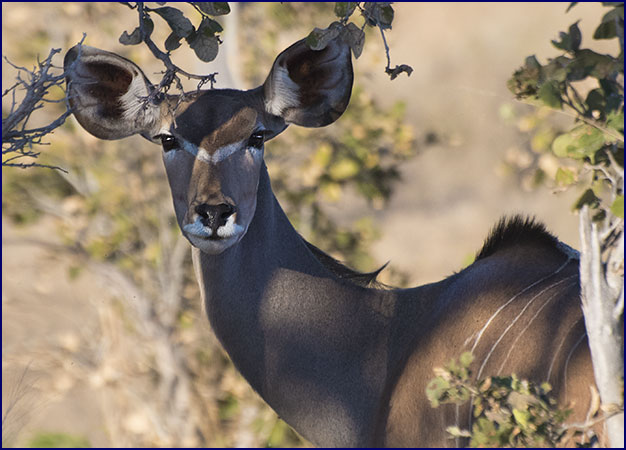
Kudu doe |
We
drove up the Savuti Channel, a wide bone-dry riverbed through
undulating ground. It was some of the prettiest countryside we had
seen. Gee said it floods in the rainy season, but it was hard to
imagine it full of water. Does it become a flowing river, or just
a marsh? I have never been to Botswana during the rainy season,
but at that moment I started to become very curious about what it
would be like.
We
had been driving for about an hour since leaving the waterholes
when we arrived at the den. There were three half-grown spotted
hyena cubs outside the entrance, lying pressed tightly together,
sleeping. One of them raised his head and looked around when we
drove up, but the other two couldn’t be bothered. Gee said they
were about 2 to 3 months old. They are one of the few animals born
with teeth, he told us. As adults, they have very powerful jaws
and teeth which can even crack elephant bones. Hyenas, like lions
and wild dogs, are very social animals. They live in groups, and
share in the care of the babies – mothers will suckle each
other’s young. Hyenas are great scavengers, but they can also be
fierce hunters.
|
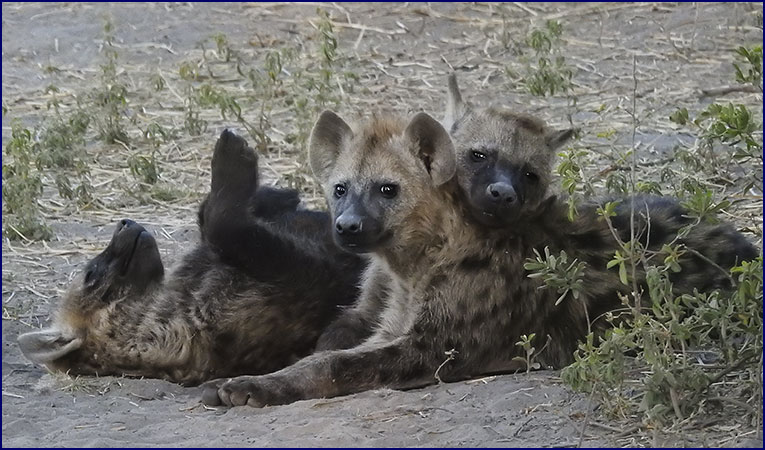
Spotted
hyena cubs |
After
a while the young hyenas started to sit up, look around and sniff
the air. One rolled on his back, front legs held folded in front
of his chest – he reminded me of an upside-down bat. Another
stood and yawned, displaying impressive teeth, and then walked off
from the others – I figured he was probably going to check the
tires. The two remaining youngsters started to wrestle gently,
rolling on the ground and chewing on each other’s faces. The
first one came back, scratched at fleas for a while, and then
coerced the others to get up.
They all walked around a bit, looking to see what they
could find. One chased a bird, though with little chance of
catching it. Another scavenged around and found a prize; a chunk
of dried elephant dung. He picked it up proudly, and the others
immediately tried to take it from him - a good-natured tussle
ensued with a three way tug-o-war. Hyenas have a bad reputation,
and are not generally considered the most beautiful of animals,
but I find them fascinating and oddly appealing, especially the
young ones. We watched the sunset with the hyenas and then headed
for camp.
The
guys had been preparing for moving camp the next day; when we got
back the dining tent was packed away and our bucket showers had
been removed. We had dinner under the stars, and then sat around
the fire and relived the day’s adventures. That morning when we
watched the lions drinking, their reflections mirrored in the
water, I couldn’t have imagined that anything could top that for
the high point of the day. But then we saw the leopard go up into
the tree . . . And the elephants walking right into our tea break.
. . And the jackal stealing the lung. . . And the elephants in the
mud bath. . . And the baby hyenas playing tug-o-war. . . It seemed
that the talisman we had given Gee was bringing powerful good
luck.
|